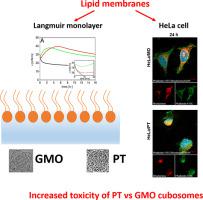Biochimica et Biophysica Acta (BBA) - General Subjects ( IF 2.8 ) Pub Date : 2020-09-18 , DOI: 10.1016/j.bbagen.2020.129738 Elżbieta Jabłonowska 1 , Dorota Matyszewska 2 , Ewa Nazaruk 1 , Marlena Godlewska 3 , Damian Gaweł 4 , Renata Bilewicz 1

|
The interactions of liquid-crystalline nanoparticles based on lipid-like surfactants, glyceryl monooleate, monoolein (GMO) and 1,2,3-trihydroxy-3,7,11,15-tetramethylhexadecane, phytantriol (PT) with selected model lipid membranes prepared by Langmuir technique were compared. Monolayers of DPPC, DMPS and their mixture DPPC:DMPS 87:13 mol% were used as simple models of one leaflet of a cell membrane. The incorporation of cubosomes into the lipid layers spread at the air-water interface was followed by surface-pressure measurements and Brewster angle microscopy. The cubosome - membrane interactions lead to the fluidization of the model membranes but this effect depended on the composition of the model membrane and on the type of cubosomes. The interactions of PT cubosomes with lipid layers, especially DMPS-based monolayer were stronger compared with those of GMO-based nanoparticles. The kinetics of incorporation of cubosomal material into the lipid layer was influenced by the extent of hydration of the polar headgroups of the lipid: faster in the case of smaller, less hydrated polar groups of DMPS than for strongly hydrated uncharged choline of DPPC. The membrane disrupting effect of cubosomes increased at longer times of the lipid membrane exposure to the cubosome solution and at larger carrier concentrations. Langmuir monolayer observations correspond well to results of studies of HeLa cells exposed to cubosomes. The larger toxicity of PT cubosomes was confirmed by MTS. Their ability to disrupt lipid membranes was imaged by confocal microscopy. On the other hand, PT cubosomes easily penetrated cellular membranes and released cargo into various cellular compartments more effectively than GMO-based nanocarriers. Therefore, at low concentrations, they may be further investigated as a promising drug delivery tool.
中文翻译:

暴露于植物三醇和单油精立方脂质体分散体的脂质膜:Langmuir单层膜和HeLa细胞膜研究。
基于脂质样表面活性剂,单油酸甘油酯,单油精(GMO)和1,2,3-三羟基-3,7,11,15-四甲基十六烷,植烷三醇(PT)的液晶纳米颗粒与所选模型脂质膜的相互作用通过Langmuir技术进行了比较。DPPC,DMPS的单层及其混合物DPPC:DMPS 87:13 mol%被用作细胞膜一张小叶的简单模型。将cubosomes掺入在空气-水界面处扩散的脂质层中,然后进行表面压力测量和Brewster角显微镜检查。立方体与膜的相互作用导致模型膜的流态化,但是这种作用取决于模型膜的组成和立方体的类型。PT cubosomes与脂质层的相互作用,尤其是基于DMPS的单分子层比基于GMO的纳米粒子更强。脂质体中极性头基的水合作用程度影响将立方体物质掺入脂质层的动力学:与较小水合的DMPS极性较小的极性基团相比,DPPS的水合性强的水合快得多。脂质体暴露于立方体溶液的时间越长,载体浓度越高,立方体脂质体的膜破坏作用就越大。朗缪尔(Langmuir)单层观察与暴露于立方体的HeLa细胞的研究结果非常吻合。MTS证实了PT立方糖的毒性更大。通过共聚焦显微镜对它们破坏脂质膜的能力进行了成像。另一方面,PT立方微粒比基于GMO的纳米载体更容易穿透细胞膜并将货物更有效地释放到各个细胞隔室中。因此,在低浓度下,它们有可能作为有前途的药物输送工具而被进一步研究。











































 京公网安备 11010802027423号
京公网安备 11010802027423号